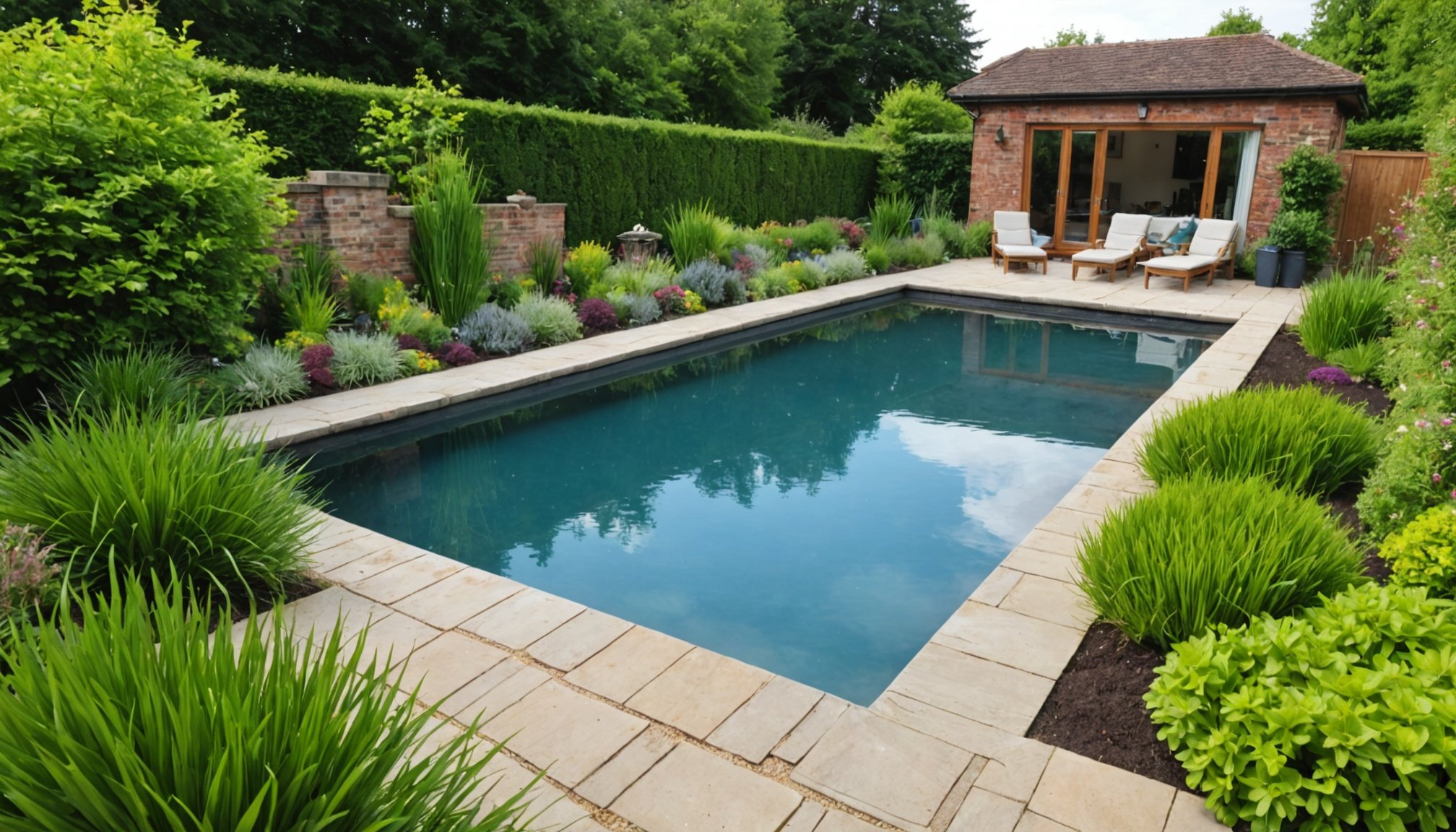Introduction to Aquatic Plants and Water Quality Improvement
Aquatic plants play a crucial role in enhancing water quality, especially in pool maintenance. These plants act as natural filters, reducing harmful chemicals and contaminants. Through the process of phytoremediation, aquatic plants absorb excess nutrients in water, resulting in clearer, healthier water. Home pools across the UK can significantly benefit from incorporating these natural filters.
Integrating aquatic plants into pool settings not only improves water quality but also creates a balanced ecosystem. Such practices reduce the reliance on chemical treatments, ensuring the pool environment is more sustainable. This approach lowers the occurrences of algae growth and ensures the water remains crystal clear for longer periods.
A lire également : Maximize Your UK Home Pool”s Water Retention: Harnessing Wind Barriers to Combat Evaporation
However, there are common misconceptions about using aquatic plants in pools. One misbelief is that aquatic plants can overrun a pool and require intensive maintenance. On the contrary, with proper selection and management, these plants require minimal upkeep while providing substantial water quality improvement. Another misconception is that aquatic plants attract pests when, in fact, they can deter mosquitoes by maintaining a balanced aquatic environment.
Embracing aquatic plants for water quality improvement ensures a more eco-friendly and aesthetically pleasing pool experience for UK homeowners.
A lire également : Essential Tips for Selecting the Perfect Pool Alarms to Keep UK Homes with Children Safe
Types of Aquatic Plants Suitable for UK Pools
In the context of the UK’s unique climate, selecting the right aquatic plant species for pools can enhance aesthetics and improve water quality. These plants fall into three main categories: floating, submerged, and emergent.
Floating Plants
Floating plants such as water lilies and duckweed simply drift on the pool’s surface. Their key characteristic is versatility, as they can adapt to different pool sizes and do not require anchoring in soil. These plants offer notable benefits, providing shade that reduces algae growth and improving water quality by absorbing excess nutrients. However, regular maintenance is crucial to prevent overgrowth, which involves thinning them out periodically.
Submerged Plants
Submerged plants like hornwort and waterweed serve essential functions in pool ecosystems. These species, ideal for UK pools, offer oxygenation and nutrient absorption. For optimal results, plant them in nutrient-rich substrates at the pool’s bottom. Regular pruning encourages healthy growth and prevents them from occupying too much of the pool.
Emergent Plants
Emergent plants such as cattails and rushes grow partially above water, creating a visually appealing and natural look. These plants not only provide ecological benefits but also contribute to water filtration. Species like marsh marigold thrive in UK climates. Strategic planting along the pool’s edges ensures their efficient growth and water purification.
Benefits of Using Aquatic Plants in Home Pools
Aquatic plants can transform a home pool into a thriving ecosystem, engaging both property owners and nature enthusiasts alike. One of the foremost benefits of aquatic plants is their role in natural filtration. By absorbing nutrients and pollutants, these plants help keep water clear, reducing dependency on chemical treatments. This natural process aligns perfectly with goals of enhancing energy efficiency by significantly reducing the frequency and intensity of electric filtration systems’ use.
Furthermore, the integration of aquatic plants in your pool can lead to substantial energy and cost savings. With a decline in chemical usage, expenses on pool maintenance are substantially lower. This not only minimizes energy consumption but also presents an eco-friendly solution for modern homes seeking sustainable living options.
Aside from the practical advantages, the aesthetic and ecological benefits of a plant-enhanced pool cannot be overstated. Aquatic plants provide a lush, inviting environment that appeals to the senses while fostering a habitat for local wildlife. Such enhancements further elevate the overall atmosphere, allowing homeowners to experience a slice of nature’s beauty and tranquillity.
Incorporating these plants into pool designs represents a harmonious blend of cutting-edge energy efficiency techniques with timeless ecological preservation strategies.
Practical Tips for Implementing Aquatic Plants
Successfully integrating aquatic plants into your pool requires thoughtful implementation strategies.
Choosing the Right Plants
Selecting the appropriate plants is crucial. Consider factors such as sunlight exposure, water depth, and the climate of your region. Opt for species like Water Lilies or Hornwort, thriving in UK climates. Sourcing from trusted nurseries ensures you get healthy, suitable plants. Local horticulturists can provide invaluable insights on species that flourish in your specific aquatic environment.
Planting Techniques
Begin with a step-by-step guide: Start by preparing the soil or substrate in the pool’s vicinity. Ensure each plant is spaced correctly, providing ample room for growth. Plant arrangement should maximise sunlight and water flow. Decide between using pots or planting directly. Pots allow easy repositioning and control, while direct planting offers a more natural appearance.
Ongoing Maintenance and Care
Effective maintenance strategies are vital for the longevity of aquatic flora. Regular monitoring of water quality and checking for pests ensures plants remain healthy. Address common problems like algae overgrowth through proper nutrient regulation and cleaning. Lastly, consider seasonal adaptations, such as protecting plants from frost in winter to ensure year-round vitality.
Case Studies and Success Stories
Exploring real-life case studies can provide valuable insights into what works when integrating aquatic plants into pools. Let’s take a glimpse into the experiences of UK homeowners who have successfully embraced this eco-friendly trend.
One noteworthy example is the Smith family, who transformed their pool area into a lush oasis. By introducing various native aquatic plants, they improved not only the pool’s aesthetics but also the overall water quality. Mr. Smith mentioned that one of the crucial lessons learned was beginning with species that thrive in the local climate, which reduced maintenance concerns significantly.
For many UK homeowners, successful implementation often involves selecting a balanced variety of aquatic plants. Some popular choices include water lilies for their striking visual appeal and duckweed for its natural filtration properties. These real-world examples illustrate how strategically chosen plants can transform an ordinary pool into an extraordinary landscape.
From these success stories, a critical takeaway is the importance of understanding how specific plants influence both aesthetics and water quality. Homeowners found that even minor changes in plant types could noticeably enhance the biochemistry of their pools. For the best possible outcome, it’s advisable to start with a modest selection and gradually expand as you gain confidence and understanding.
Resources and Further Reading
For those eager to dive deeper into aquatic gardening and pool care, several resources can expand your understanding and enhance your skills.
Exploring recommended books and articles is a great starting point. “The Practical Guide to Water Gardening” and “Aquaculture and Pool Mastery” are popular choices among enthusiasts. These expert guides provide comprehensive insights into aquatic plant species, care techniques, and environmentally-friendly pool maintenance.
Online communities and forums are invaluable for connecting with fellow aquatic gardening enthusiasts. Platforms like the Aquatic Plant Society forum and the Pool Care Professionals Facebook group offer active discussions, Q&A sessions, and shared personal experiences. Engaging in these communities allows you to exchange practical tips, troubleshoot issues, and find inspiration for your projects.
Consider reaching out to professional organizations such as the Aquatic Gardeners Association or local horticultural clubs. These organizations often host workshops, educational events, and provide access to exclusive materials. They can also connect you with local experts who offer personalized advice and support in your aquatic gardening endeavors.
Embrace these resources and watch your aquatic gardening knowledge bloom, contributing to a thriving pool environment that combines aesthetics with healthy living ecosystems.












